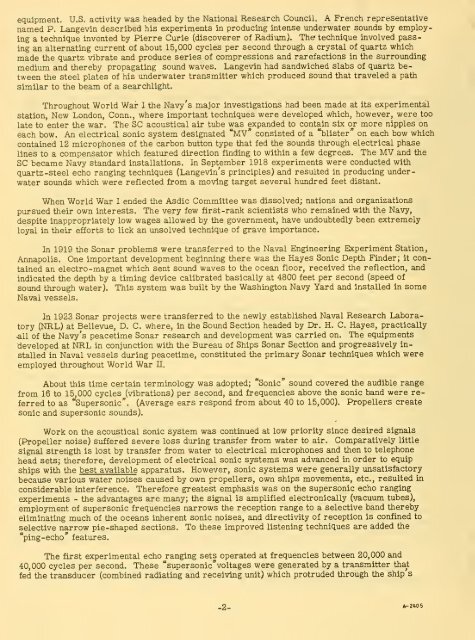Sonar : detector of submerged submarines
Sonar : detector of submerged submarines
Sonar : detector of submerged submarines
Create successful ePaper yourself
Turn your PDF publications into a flip-book with our unique Google optimized e-Paper software.
equipment. U.S. activity was headed by the National Research Council. A French representative<br />
named P. Langevin described his experiments in producing intense underwater sounds by employing<br />
a technique invented by Pierre Curie (discoverer <strong>of</strong> Radium). The technique involved passing<br />
an alternating current <strong>of</strong> about 15,000 cycles per second through a crystal <strong>of</strong> quartz which<br />
made the quartz vibrate and produce series <strong>of</strong> compressions and rarefactions in the surrounding<br />
medium and thereby propagating sound waves. Langevin had sandwiched slabs <strong>of</strong> quartz between<br />
the steel plates <strong>of</strong> his underwater transmitter which produced sound that traveled a path<br />
similar to the beam <strong>of</strong> a searchlight.<br />
Throughout World War I the Navy's major investigations had been made at its experimental<br />
station, New London, Conn,, where important techniques were developed which, however, were too<br />
late to enter the war. The SC acoustical air tube was expanded to contain six or more nipples on<br />
each bow. An electrical sonic system designated "^V" consisted <strong>of</strong> a "blister" on each bow which<br />
contained 12 microphones <strong>of</strong> the carbon button type that fed the sounds through electrical phase<br />
lines to a compensator which featured direction finding to within a few degrees. The MV and the<br />
SC became Navy standard installations. In September 1918 experiments were conducted with<br />
quartz-steel echo ranging techniques (Langevin's principles) and resulted in producing underwater<br />
sounds which were reflected from a moving target several hundred feet distant.<br />
When World War I ended the Asdic Committee was dissolved; nations and organizations<br />
pursued their own interests. The very few first-rank scientists who remained with the Navy,<br />
despite inappropriately low wages allowed by the government, have undoubtedly been extremely<br />
loyal in their efforts to lick an unsolved technique <strong>of</strong> grave importance.<br />
In 1919 the <strong>Sonar</strong> problems were transferred to the Naval Engineering Experiment Station,<br />
Annapolis. One important development beginning there was the Hayes Sonic Depth Finder; it contained<br />
an electro -magnet which sent sound waves to the ocean floor, received the reflection, and<br />
indicated the depth by a timing device calibrated basically at 4800 feet per second (speed <strong>of</strong><br />
sound through water). This system was built by the Washington Navy Yard and installed in some<br />
Naval vessels.<br />
In 1923 <strong>Sonar</strong> projects were transferred to the newly established Naval Research Laboratory<br />
(NRL) at Bellevue, D. C. where, in the Sound Section headed by Dr. H. C. Hayes, practically<br />
.all <strong>of</strong> the Navy's peacetime <strong>Sonar</strong> research and development was carried on. The equipments<br />
developed at NRL in conjunction with the Bureau <strong>of</strong> Ships <strong>Sonar</strong> Section and progressively installed<br />
in Naval vessels during peacetime, constituted the primary <strong>Sonar</strong> techniques which were<br />
employed throughout World War 11.<br />
About this time certain terminology was adopted; "Sonic" sound covered the audible range<br />
from 16 to 15.000 cycles (vibrations) per second, and frequencies above the sonic band were referred<br />
to as Supersonic". (Average ears respond from about 40 to 15,000). Propellers create<br />
sonic and supersonic sounds).<br />
Work on the acoustical sonic system was continued at low priority since desired signals<br />
(Propeller noise) suffered severe loss during transfer from water to air. Comparatively little<br />
signal strength is lost by transfer from water to electrical microphones and then to telephone<br />
head sets; therefore, development <strong>of</strong> electrical sonic systems was advanced in order to equip<br />
ships with the best available apparatus. However, sonic systems were generally unsatisfactory<br />
because various water noises caused by own propellers, own ships movements, etc., resulted in<br />
considerable interference. Therefore greatest emphasis was on the supersonic echo ranging<br />
experiments - the advantages are many; the signal is amplified electronically (vacuum tubes),<br />
employment <strong>of</strong> supersonic frequencies narrows the reception range to a selective band thereby<br />
eliminating much <strong>of</strong> the oceans inherent sonic noises, and directivity <strong>of</strong> reception is confined to<br />
selective narrow pie-shaped sections. To these improved listening techniques are added the<br />
"ping-echo" features.<br />
The first experimental echo ranging sets operated at frequencies between 20,000 and<br />
40,000 cycles per second. These "supersonic"voltages were generated by a transmitter that<br />
fed the transducer (combined radiating and receiving unit) which protruded through the ship s<br />
A-2U0 5

















